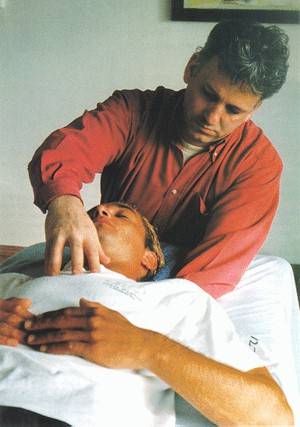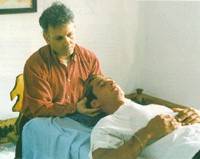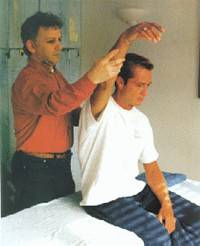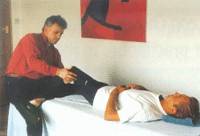Positive Health Online
Your Country

Zero Balancing
listed in zero balancing, originally published in issue 30 - July 1998
What is Zero Balancing?
Zero Balancing (ZB for short, pronounced Zee Bee), can be defined as the art and skill of balancing body energy with body structure through touch.
The working focus in Zero Balancing is the interface between the structure of the bones, joints and soft tissues and the energy flowing through our skeletal system. Zero Balancing uses specific finger pressure and held stretches, called fulcrums. A fulcrum provides a point of stillness around which energy and structure can reorganise, giving a person the opportunity to let go of held tension and pain and experience new levels of integration. The results have a gentle power and contribute to an overall enhancement of wellbeing.
The energy flowing through the most fundamental level of our structure, our bones, can be most easily evaluated at the joints. Zero Balancing focuses on particular joints that have more to do with transmission of energy rather than with locomotion. Examples of these include the sacroiliac joints and the articulations between the tarsal bones of the feet, which are referred to as foundation joints. One of the key characteristics of these joints is their limited range of motion.

Balancing a fulcrum in the ribs of the Upper Back and Sternum
They have no intrinsic musculature, which allows the conscious movement of one bone in relation to the other. Imbalances which occur at these joints will be below our level of consciousness, because they lack the proprioceptive input from the muscles.
The body tends to compensate in a broad manner for these imbalances rather than deal with them locally. Since these joints play such a crucial role in structural integrity and energy transmission, small changes here will amplify throughout the body with often adverse consequences.
As we know, the contraction and expansion of the muscles moves the joints.
The ligaments, however, provide a passive support, limiting the motion of the joint. In Zero Balancing we evaluate the structure and energy of the body through moving the joints until the ligaments begin to engage. The quality of the ligaments, (be it too tight or too loose), gives us valuable information.
Following a working protocol whereby we first evaluate the range of motion of a joint, the fulcrums are used to balance the body, then we reevaluate to assess any changes that occur. This provides us with direct feedback whereby we can monitor the effectiveness of Zero Balancing.
What is meant by body structure and body energy?
Bodywork therapies can range from approaches in which the body is seen as a mechanical structure to ways which recognise its vital energy. The value of Zero Balancing is that it works with both structure and energy.
From our knowledge of physics we know that light can be both particle and wave, we could say that the particle represents structure, and wave represents energy, and that these two forms are interchangeable. In one sense they are both energy, just different manifestations of energy. In Zero Balancing we look at the human body as having an energetic body and a physical body. They are dependent on each other, are interrelated but are not mirror images. We know that our physical body ends at our skin and our energy body extends beyond our skin. It is possible to feel the heat coming from someone's body without actually touching them; some people can see an auric field around a person's body.
Any time we have trauma to the body, be it physical, emotional, mental, all these will have a vibratory aspect and to that extent will be in the energy field. Thought is a vibration and will have an energetic component to it.
The focus of interest in Zero Balancing is where these two bodies meet and how they are interrelated. Experience has shown us that anything that has a vibratory nature can be stored in the body. When there are imbalances, they no longer serve us (they can occur at conscious or unconscious level). By putting in clearer stronger force fields of energy these can be released from our Body/Mind/Spirit.
Learning the Vocabulary of Touch
One of the major contributions within the health care system that Zero Balancing has to offer is the understanding and application of "INTERFACE" the specific therapeutic touch that is used.
It is important to have an appreciation of the numerous ways of touching the energy of another person used in other approaches and therapies, in order to clarify the distinctions.
The different types of touch used in healing and the fundamental relationship of touch when working with energy give us a General Vocabulary of Touch. These are: Blending; Streaming; Channelling; Interface.
Blending
Blending is the deliberate blurring of the boundary between your energetic body and another's. You fuse or merge into each other's fields. This is an approach used with great success in Cranial Sacral work.
Streaming
This is when the practitioner directs or allows their energy to flow into their client. This may be with specific intention, for example to direct energy along a meridian to an acupuncture point or to a particular chakra.
It may be experienced as heat, light or a current by the receiver.The energy used comes directly from the energy bank of the practitioner.
Channelling
This is opening yourself up to forces beyond yourself so that you become a conduit of transmission of these, through you to others.
Interface
The interface maintains clear energetic and structural boundaries, establishing a clear working relationship of conscious touch. We as practitioners are clear where we end and where the client begins.
We can relate appropriately to our client's structure/energy, with our own energy/structure.

Integrating the Energies of the Neck and Upper Back

Evaluation of the Shoulder Girdle

Placing a Fulcrum to the Hip, helping to integrate the energies of the hip and sacro-iliac joints
The value of working at interface
When the boundaries are unintentionally lost, blending or streaming may occur. Which means that your energy fields can merge, resulting in the possibility of picking up things from your clients. Or the energy will stream from you, depleting your own reserves, or allowing the client's energy to come into you thus taking on your client's own problems. Both of these, if unintended, can be potentially harmful for us.
When we have a clear interface we won't pick up anything from the other person.
"Burn out" is now an all to common problem for people working in the health care field. One of the main reasons for this is losing the clear practitioner/client boundaries.
With the clarity of this conscious touch we as practitioners become clearer in ourselves, and at the same time eliminate being drained by our clients.
Donkey-Donkey Contact
The "DONKEY-DONKEY CONTACT" is another powerful contribution that Zero Balancing has to offer. It is a particular principle that requires connection with our client both energetically and structurally, and at the same time maintaining a clear distinct interface, all the time knowing who's who, keeping the boundaries, and not allowing the energies to intermingle.
The donkey-donkey contact is one of trust.
The analogy – Picture two donkeys walking up a narrow mountain path, both donkeys are leaning into each other, if one donkey were to suddenly move and lose the interface connection, both donkeys' lives would be in danger.
They lean into each other instinctively trusting each other. They are continually adapting their contact/lean as they navigate the terrain, feeling safe and confident with the donkey they are leaning into.
The quality of the donkey touch is one of healing and exemplifies safety and respect.The touch is not sensual, ie, stroking. It is contacting the essence of that person.
Many of us are starved of this type of touch. It can break down the feelings of separation, alienation and loneliness, to be replaced by a feeling of connectedness and belonging.
There is an implicit recognition that no two donkeys are the same, what suits one donkey in terms of strength and intensity of support, may not suit another.
Therefore the practitioner is continually adapting his or her quality of touch to meet the donkey of the client.
Who benefits from Zero Balancing?
Zero Balancing is wonderful for stress reduction, so anything which is related to stress can be helped with Zero Balancing as we begin to move the energy through the body.
When we begin to have clearer fields in the body, what happens is that any stress that comes in will be able to flow out more easily, allowing the person to process stress with greater ease. Stress can manifest itself as emotional/mental and or physical problems.
For some a Zero Balancing session is the only chance they have to reach a point of stillness where profound changes may take place. It is one of the paradoxes involved in the work of Zero Balancing that such a simple gentle approach can have such potential and power for change in a person's life.
Many clients report therapeutic responses ranging from the physical relief of pain, increase flexibility in their body to a level of refreshing relaxation and experience of integration. Others report that its therapeutic impact is so profound as to evoke spiritual metaphors and being similar to the deep peaceful state reached from intensive meditation.
Zero Balancing can be of great help to those who want to feel more integrated in themselves. We all know the times when we feel "out of sorts", at "sixes and sevens", not feeling quite right in our self.
It can help during or after transitional periods in one's life, "when the winds of change begin to blow in conflicting directions". Zero Balancing significantly improves our ability to adapt to changes that life is continually confronting us with. During a Zero Balancing session clients often enter into "Expanded States of Consciousness" as the body/mind/spirit responds and reintegrates during and following a shift of balance or vibration. This is a place where we become less attached to our selves, away from who we've been taught to believe we are, and enables us to "let go of tension and patterns that no longer serve us". Having a "body felt" experience can allow a faster and richer vibration going through our whole psyche, where healing can occur faster and more completely.
Zero Balancing can allow access into early life experiences and help to release childhood patterns that impede growth and freedom. Much reparative work has been achieved for those with abuse history. Each time we provide an experience contrary to the early imprints, a clearer touch vibration of healing, this body felt experience becomes a truth for them and begins to override their past patterning. A new safe experience becomes absorbed into their being. Whole new worlds of potential can open up.
As you can see the scope and potentials of using Zero Balancing is wide ranging, the skilled practitioner adapting the way they work to suit the energetic needs of the client.
Zero Balancing through its understanding of the mechanics of body energy and body structure, with its simplicity of transmission and practice, its extensive therapeutic impact, contains all the ingredients to make it one of the most powerful forms of bodywork that we know. This can only advance us in our quest to help and serve others.
How did Zero Balancing originate?
The name 'Zero Balancing' came from a client's description of her experience: "I feel so perfectly balanced; it's almost like I am zero balanced". Her meaning was that she had been brought back to the experience of an original state.
Dr Fritz Frederick Smith, the American originator of this bodywork approach, received his Bachelor of Science in 1951, Doctor of Osteopathy in 1955 and Medical Degree in 1961. He practised osteopathy and general medicine from 1957 to 1972. During the 1960s and 70s, seeking a deeper understanding of illness and health, he became a student of yoga and meditation as well as a certified Rolfer and a licensed acupuncturist. His scientific viewpoint was increasingly challenged by Eastern influences and particularly by his clinical experience of acupuncture.
In 1975, while studying with Professor J.R. Worsley at the College of Traditional Acupuncture in England, he evolved Zero Balancing as a project of excellence for his Bachelor of Acupuncture degree. He has since taught Zero Balancing internationally to thousands of practitioners. In 1986 he published his book, Inner Bridges, which describes the path of discovery that led to Zero Balancing. In 1991 Dr Smith retired from active practice and now devotes himself to the development and teaching of Zero Balancing. There are 13 certified teachers in the UK, 31 in the USA and 1 in Switzerland.
Who Practices Zero Balancing?
Zero Balancing integrates a Western anatomical view of structure with knowledge about our vital energy and the process of healing from Oriental traditions. With this information as background, the practical foundations of Zero Balancing are presented with an emphasis upon direct hands-on learning.
The Basic Zero Balancing Workshops are designed to teach health care professionals who are already licensed to practise some form of medicine or therapy. Although it may be used as a body work skill in its own right, the many acupuncturists, osteopaths, chiropractors, masseurs, physiotherapists, homoeopaths, counsellors and others who have trained as Zero Balancers, find that it significantly enhances their skills and effectiveness when used in conjunction with their primary therapy.
The Basic level of Zero Balancing is presented in two Workshops, Basic 1 & Basic 2.
Basic 1 teaches the fundamental theory and skills: accessing energy through touch, balancing energy with structure, evaluating the movement of energy in the body, and working with expanded states of consciousness. The participant will gain a practical understanding of the body energies, the healing process, and a working knowledge of Zero Balancing. By the end of the workshop you will be able to explore the use of Zero Balancing.
Basic 2 deepens the Basic 1 material, allowing for a deeper understanding, refinement of skills, empowerment of touch, and amplification of the ability to work with expanded states of consciousness.
The Subject areas presented through lecture and demonstration, followed by supervised student practice are shown in Table 1.
You will learn a Protocol that integrates all that has been presented, giving you an effective guide to working with the whole person in a way that is infinitely adaptable to individual needs.
My Personal Experience
In my own process of learning ZB, following on from studying the basic Zero Balancing work, I took an advanced workshop with the founder, Fritz Smith. I had been using Zero Balancing in my practice and was keen to develop more understanding and sensitivity in my hands. On the third day of the workshop I was the fortunate one who was going to have a session from the originator of Zero Balancing himself. My classmates were all eager to see Fritz give another class demonstration.
To start off with I sat down on the edge of the treatment couch. After an initial evaluation of my shoulder joints and lower back I laid fully clothed on my back. During the next 25 minutes or so Fritz worked on me with grace and expertise, evaluating specific joints to discover their quality of motion, then using gentle supporting held pressures and soft integrating stretching movements to balance my energy.Initially I can remember thinking that not much was happening, until I found myself drifting into what can only be described as a very deep, profound meditative state.
To my classmates Fritz embodies the finesse of decades of experience that is analogous to the deep level obtained by a skilled master of Tai Chi.There's a certain quality of seemingly little work to the observer but the depth of this gentle conscious touch was certainly taking me into a deeper level than I had experienced with any other type of bodywork.
After what had only seemed like minutes, I got off the couch feeling more complete, calmer, taller, freer in myself and generally more alive than I can ever remember.The following day I went for an early morning walk, it was about 6.00am and I was feeling alive and very awake. Just me, the birds and rabbits, all the colours seemed brighter, visually everything was clearer. I started to sing. To many this might not seem anything special, but as a child and throughout my early adult-hood, in fact, up until that moment I hadn't been able to sing in tune. At school when we used to sing I would mime for fear of my deep low voice being heard, even singing in the bath tub was an experience to miss. I started singing "Amazing Grace", I could feel the years of tension and anxiety related to singing had eased away, I was reaching higher notes than ever before.
The work done the previous day had released the vibration and fear I had held in my body, my whole thoracic cage felt fuller and more at ease. The sense of freedom and accomplishment as you can imagine was huge. For the first time in my life I could sing.
The book Inner Bridges by Dr Fitz Frederic Smith is available from Positive Health.
Learning touch skills will help you to:
1) Understand and be able to use touch more skilfully and appropriately in the treatment room.
2) Develop the sensitivity at your fingertips.
3) Develop clarity and focus of mind.
4) Learn how to energetically connect and disconnect.
5) Understand how energy gets exchanged / transferred.
6) Develop an instinctive rapport, (donkey/donkey).
7) Maintain your own and your clients' wellbeing.
8) Stimulate an on-going curiosity and discovery.
9) Develop a greater understanding of energy and movement within ourselves, our clients and globally.
Table 1: Subject Areas
• Zero Balancing Theory.
• Eastern energy concepts as related to bodywork.
• Energy as a specific working tool; the interface of energy and structure; the boundaries and skills of energetic touch.
• Using Fulcrum and Vectors as ways of assisting balancing.
• Following a process of evaluating, balancing and re-evaluation as a working method.
• Developing a touch that contacts structure and energy simultaneously.
• Western anatomy from the energy perspective; the skeleton as the energy armature of the body; the energetic significance of foundation and semi-foundation joints, and the energetics of joint function.
• Recognising the signs of internal change that indicates a working state.
• Working with altered and expanded states of consciousness.
• Red flags; contraindications for energy work; when to refer to medical profession.
The Zero Balancing Association
For details of Zero Balancing Workshops in 1998, including Devon, West Wales, Cornwall, London & West Sussex and for a list of Certified Zero Balancers contact;
ZBA UK, 10 Victoria Grove, Bridport, Dorset, DT6 3AA,
Tel: 01308 420 007,
E: ZBAUK@aol.com
Comments:
-
No Article Comments available